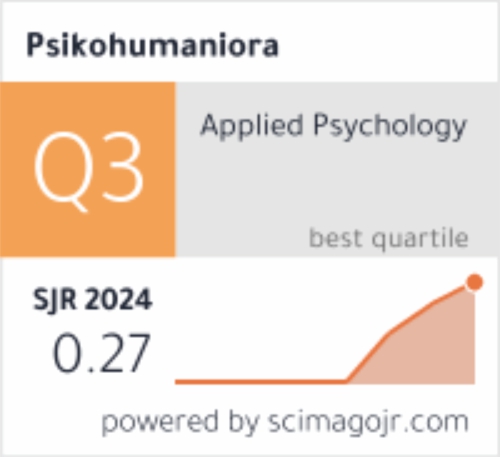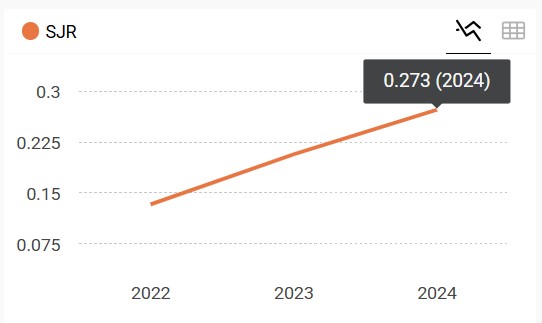Social media pressure and the body dysmorphic disorder tendency in women: The mediating role of perfectionism
DOI:
https://doi.org/10.21580/pjpp.v7i2.10637Keywords:
body image, emerging adulthood, Indonesian women, perfectionism, social mediaAbstract
The ideal body image displayed in social media often makes women vulnerable to body image issues, one of which is body dysmorphic disorder (BDD). This study aims to examine the role of social media pressure in predicting the tendency towards such a disorder in emerging adult women, with each of the three dimensions of perfectionism as a mediator. The participants were 385 women aged 18-25 years who used social media and were selected using the convenience sampling technique. Data were collected using the Body Dysmorphic Disorder Screening Scale, Social Media Pressure Scale, Almost Perfect Scale-Revised (APS-R), and some open-ended questions distributed online through various social media. The BDD tendency model tested using structural equation modeling has a good fit with the data (χ2/df = .019, RMSEA = .001, CFI = 1.00) and shows that the role of social media pressure in women's BDD tendency was fully mediated through the discrepancy dimension of perfectionism. The findings indicate that a program is needed to develop media literacy and promote positive body images for women who use social media to prevent body image issues.Downloads
References
American Psychiatric Association. (2013). Diagnostic and statistical manual of mental disorders (5th ed.). American Psychiatric Association. https://doi.org/10.1176/appi.books.9780890425596
Arji, M., Borjali, A., Sohrabi, F., & Farrokhi, N. A. (2016). Role of perfectionism and body image in the prediction of body dysmorphic disorder symptoms. Avicenna Journal of Neuro Psych Physiology, 3(3), 62–65. https://doi.org/10.5812/ajnpp.42560
Arnett, J. J. (2000). Emerging adulthood. A theory of development from the late teens through the twenties. The American Psychologist, 55(5), 469–480. http://www.ncbi.nlm.nih.gov/pubmed/10842426
Aviles, G. (2020). Isolation, Zoom calls amid coronavirus worsen body dysmorphic disorder symptoms for some. NBC News. https://www.nbcnews.com/news/us-news/body-dysmorphic-disorder-tk-n1235481
Barnett, M. D., & Sharp, K. J. (2016). Maladaptive perfectionism, body image satisfaction, and disordered eating behaviors among U.S. college women: The mediating role of self-compassion. Personality and Individual Differences, 99, 225–234. https://doi.org/10.1016/j.paid.2016.05.004
Bentler, P. M. (1990). Comparative fit indexes in structural models. Psychological Bulletin, 107(2), 238–246. https://doi.org/10.1037/0033-2909.107.2.238
Bessenoff, G. R. (2006). Can the media affect us? Social comparison, self-discrepancy, and the thin ideal. Psychology of Women Quarterly, 30(3), 239–251. https://doi.org/10.1111/j.1471-6402.2006.00292.x
Browne, M. W., & Cudeck, R. (1992). Alternative ways of assessing model fit. Sociological Methods & Research, 21(2), 230–258. https://doi.org/10.1177/0049124192021002005
Davison, T. E. (2012). Body image in social contexts. In Encyclopedia of body image and human appearance (pp. 243–249). Elsevier. https://doi.org/10.1016/B978-0-12-384925-0.00023-7
Finchman, F. D., & Cui, M. (2011). Romantic relationship in emerging adulthood. Cambridge University Press.
Foroughi, A., Khanjani, S., & Mousavi Asl, E. (2019). Relationship of concern about body dysmorphia with external shame, perfectionism, and negative affect: The mediating role of self-compassion. Iranian Journal of Psychiatry and Behavioral Sciences, 13(2). https://doi.org/10.5812/ijpbs.80186
Gillen, M. M. (2006). Body image development in emerging adulthood [Doctoral dissertation]. The Pennsylvania State University.
Hair, J. F., Black, W. C., Babin, B. J., & Anderson, R. E. (2010). Multivariate data analysis (7th ed.). Pearson Prentice Hall.
Hu, L., & Bentler, P. M. (1999). Cutoff criteria for fit indexes in covariance structure analysis: Conventional criteria versus new alternatives. Structural Equation Modeling: A Multidisciplinary Journal, 6(1), 1–55. https://doi.org/10.1080/10705519909540118
Johnson, K. M. (2017). The importance of personal branding in social media: educating students to create and manage their personal brand. International Journal of Education and Social Science, 4(1), 21–27.
Johnson, S., Williamson, P., & Wade, T. D. (2020). Perfectionism and selective attention predict dysmorphic concern in an Australian university population. Australian Psychologist, 55(2), 143–155. https://doi.org/10.1111/ap.12423
Jöreskog, K. G., & Sörbom, D. (2006). LISREL 8.80 for Windows [Computer software]. Scientific Software International Inc.
Luo, J., Forbush, K. T., Williamson, J. A., Markon, K. E., & Pollack, L. O. (2013). How specific are the relationships between eating disorder behaviors and perfectionism? Eating Behaviors, 14(3), 291–294. https://doi.org/10.1016/j.eatbeh.2013.04.003
Minoosepehr, S., Nikoogoftar, M., & Foroushani, G. S. (2014). Predictors of tendency toward cosmetic surgery: Media Influences, appearance perfectionism and investment. Practice in Clinical Psychology, 2(4), 267–270.
Murnen, S. K., & Don, B. P. (2012). Body image and gender roles. In Encyclopedia of body image and human appearance (pp. 128–134). Academic Press.
Negrin, A. R., Skemp, K. M., & Baumann, D. D. (2018). The effect of media exposure on body satisfaction and drive for muscularity in women. Frontiers in Women’s Health, 3(1), 1–9. https://doi.org/10.15761/FWH.1000138
Perloff, R. M. (2014). Social media effects on young women’s body image concerns: Theoretical perspectives and an agenda for research. Sex Roles, 71(11–12), 363–377. https://doi.org/10.1007/s11199-014-0384-6
Phillips, K. A. (2009). Understanding body dysmorphic disorder: An essential guide. Oxford University Press, Inc.
Rizwan, B., Zaki, M., Javaid, S., Jabeen, Z., Mehmood, M., Riaz, M., Maqbool, L., & Omar, H. (2022). Increase in body dysmorphia and eating disorders among adolescents due to social media. Pakistan BioMedical Journal, 5(3), 144–148. https://doi.org/10.54393/pbmj.v5i3.205
Roberts, S. R., Maheux, A. J., Hunt, R. A., Ladd, B. A., & Choukas-Bradley, S. (2022). Incorporating social media and muscular ideal internalization into the tripartite influence model of body image: Towards a modern understanding of adolescent girls’ body dissatisfaction. Body Image, 41, 239–247. https://doi.org/10.1016/j.bodyim.2022.03.002
Rosen, J. C., & Reiter, J. (1996). Development of the body dysmorphic disorder examination. Behaviour Research and Therapy, 34(9), 755–766. https://doi.org/10.1016/0005-7967(96)00024-1
Schaefer, L. M., Burke, N. L., Thompson, J. K., Dedrick, R. F., Heinberg, L. J., Calogero, R. M., Bardone-Cone, A. M., Higgins, M. K., Frederick, D. A., Kelly, M., Anderson, D. A., Schaumberg, K., Nerini, A., Stefanile, C., Dittmar, H., Clark, E., Adams, Z., Macwana, S., Klump, K. L., … Swami, V. (2015). Development and validation of the Sociocultural Attitudes Towards Appearance Questionnaire-4 (SATAQ-4). Psychological Assessment, 27(1), 54–67. https://doi.org/10.1037/a0037917
Schaefer, L. M., Harriger, J. A., Heinberg, L. J., Soderberg, T., & Kevin Thompson, J. (2017). Development and validation of the Sociocultural Attitudes towards Appearance Questionnaire-4-Revised (SATAQ-4R). International Journal of Eating Disorders, 50(2), 104–117. https://doi.org/10.1002/eat.22590
Slaney, R. B., Rice, K. G., Mobley, M., Trippi, J., & Ashby, J. S. (2001). The revised almost perfect scale. Measurement and Evaluation in Counseling and Development, 34(3), 130–145. https://doi.org/10.1080/07481756.2002.12069030
Soreni, N., Streiner, D., McCabe, R., Bullard, C., Swinson, R., Greco, A., Pires, P., & Szatmari, P. (2014). Dimensions of perfectionism in children and adolescents with obsessive-compulsive disorder. Journal of the Canadian Academy of Child and Adolescent Psychiatry [Journal de l’Academie Canadienne de Psychiatrie de l’Anfant et de l’Adolescent], 23(2), 136–143. http://www.ncbi.nlm.nih.gov/pubmed/24872829
Sukamto, M. E. (2020). Pengembangan model perilaku mengendalikan berat badan yang tidak sehat pada remaja perempuan [Unpubished doctoral dissertation]. Universitas Airlangga.
Sukamto, M. E., Hamidah, H., & Fajrianthi, F. (2019). “Can I look like her?”: Body image of adolescent girls who use social media. Makara Human Behavior Studies in Asia, 23(1), 60–72. https://doi.org/10.7454/hubs.asia.1120519
Sukamto, M. E., Karunia, N. E., Jiasheng, Z., Shiyao, Z., & Santoso, S. (2013). Body dissatisfaction and body change behaviors among Indonesian and Chinese college students. International Conference on Psychology in Health, Environmental, School, and Organization Settings, 719–724.
Tandy, E., & Sukamto, M. E. (2013). Asesmen untuk deteksi dini body dysmorphic disorder (BDD) pada remaja perempuan (Assessment to early detect body dysmorphic disorder (BDD) in adolescent girls). Jurnal Psikologi Indonesia, 10(2), 78–84.
Tiggemann, M. (2012). Sociocultural perspectives on body image. In Encyclopedia of body image and human appearance (pp. 758–765). Elsevier Academic Press.
Tiggemann, M., Hayden, S., Brown, Z., & Veldhuis, J. (2018). The effect of Instagram “likes” on women’s social comparison and body dissatisfaction. Body Image, 26, 90–97. https://doi.org/10.1016/j.bodyim.2018.07.002
Tiggemann, M., & Zaccardo, M. (2015). “Exercise to be fit, not skinny”: The effect of fitspiration imagery on women’s body image. Body Image, 15, 61–67. https://doi.org/10.1016/j.bodyim.2015.06.003
Wade, T. D., & Tiggemann, M. (2013). The role of perfectionism in body dissatisfaction. Journal of Eating Disorders, 1(1), 2. https://doi.org/10.1186/2050-2974-1-2
Wade, T. D., Tiggemann, M., Bulik, C. M., Fairburn, C. G., Wray, N. R., & Martin, N. G. (2008). Shared temperament risk factors for anorexia nervosa: A twin study. Psychosomatic Medicine, 70(2), 239–244. https://doi.org/10.1097/PSY.0b013e31815c40f1
Wertheim, E. H., & Paxton, S. J. (2012). Body image development – adolescent girls. In Encyclopedia of body image and human appearance (pp. 187–193). Elsevier. https://doi.org/10.1016/B978-0-12-384925-0.00029-8
Downloads
Published
How to Cite
Issue
Section
License
The copyright of the accepted article shall be assigned to the publisher of the journal. The intended copyright includes the right to publish the article in various forms (including reprints). The journal maintains the publishing rights to published articles.
In line with the license, authors and any users (readers and other researchers) are allowed to share and adapt the material only for non-commercial purposes. In addition, the material must be given appropriate credit, provided with a link to the license, and indicated if changes were made. If authors remix, transform, or build upon the material, authors must distribute their contributions under the same license as the original.



